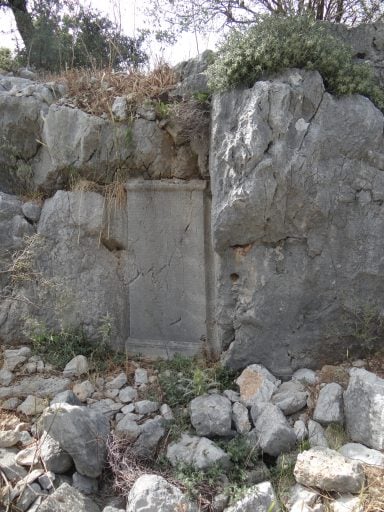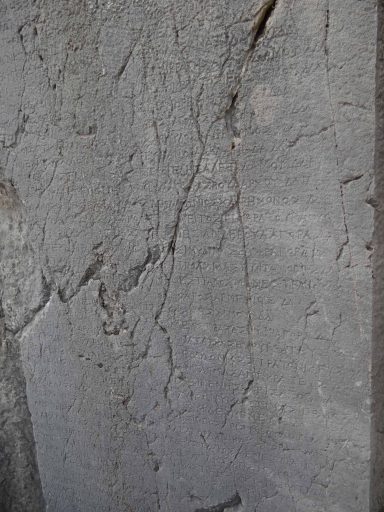
Pyramids in Anatolian Caria? Yes, it sounds a bit strange… yet they do exist!

Of course, apart from their funerary connection, these have nothing to do with the Egyptian ones. The pyramids in Caria are in fact much much smaller than the Egyptian ones, and carved out of a single block. Although many have been spotted in the Carian Chersonese, this narrow strip of land extending into the Aegean sea at the Lycian border, there is one place where they literally cover the landscape: at the foot of the slopes carrying the acropolis of an ancient site called Phoenix.

Phoenix (Foinix in Greek) is a settlement dating from the Hellenistic period, which was part of the mainland territory (the peraea) owned by Rhodes. Being a district (deme) of the Rhodian State, it was not organized as an urban centre but instead as a large rural community scattered over an extensive territory (chora) where the inhabitants’ activity was essentially concentrated on agriculture and production of oil, wine and so on. In the middle of this territory stood a meeting place, given permanent form through the construction of a stronghold protected by thick walls on the top of a hill: an acropolis which aimed at providing shelter to the population in case of danger, whether foreign invasion or endemic piracy.

Piracy had become a serious problem in the Hellenistic period. After Alexander’s death, the many wars between his former generals in this part of the Mediterranean led to a surge in piracy, either organized by independent crews of brigands or those employed by states for mercenary use. In this context, Rhodes, the dominant naval power in the area, played a major role in policing and combating this plague. Along with full-scale offensives such as the brutal Cretan War at the end of the third century BC, their measures included the erection of a defensive network all throughout their possessions.

As the most conspicuous landmark of this area, with time, the acropolis developed other functions beside the defensive. It became one of the main centres in the area for both religious and funerary activities and, as such, any declaration, decision or action that was undertaken by members of the community came to be advertised and displayed near or close to the acropolis.
One magnificent testimony of this is an inscription carved right in the middle of the acropolis, directly onto the bedrock. It’s 90 lines long - an exceptionally long text - and was engraved in the middle of the third century BC. This invaluable document is a list of donors who decided to contribute financially towards the construction of a temple dedicated to the god Dionysos. It provides us with a deep social, economic and religious insight into the community of Phoenix. It also highlights its numerous connections with the ruling Rhodian State, as many of the individuals mentioned in the Phoenix text are also known from inscriptions in Rhodes itself.


These connections between Rhodes and its continental possessions are further emphasised by another exceptional survival, this time located outside and to the north-east of the acropolis, down at the foot of the hill. It takes the shape of a large Byzantine basilica, still pretty well preserved. It was built by recycling ancient blocks that once belonged to a temple.
A couple of dedications can still be read on the reused jamb of the church’s main door, including an Apollo Pe-something (the stone is cut off halfway through the word). It’s probably short for Apollo Petasitas or Apollo Petageitnuos, both of which we know from other pieces were worshipped at Kameiros, one of the main cities constituting the Rhodian state, over on the island itself.
Back to our pyramids

For the ancients at Phoenix, what followed after life was as much a concern as it is for many today. The dead would benefit in a life after death for as long as they were remembered by the living. It was therefore not only important to have an ostentatious tomb if you had the means to do so, but also a tomb located in a particularly visible place.
This explains how and why the surroundings of the acropolis at Phoenix, being a favoured spot to show and to show off, attracted a large necropolis composed of fancy tombs. Yet, the fanciness did not reside in the burials themselves, which were subterranean, but in the above-the-ground monuments that trumpeted their presence. Placed above the burial, they had the shape of a monolithic stepped pyramid of 2 or 3 degrees inclination. Their basic role was to provide a base for a sign (sema), in the shape of an inscribed stele or a relief, inserted in a slot carved at the top of the monument. These semata were principally erected in order to attract the attention of passers-by and to ensure that the memory of the dead would not fade with time.

Such monuments are widely-known throughout the Greek world, but mainly through painted representations of funerary ceremonies on ancient vases, mostly the type called white ground lekythoi, rather than as the actual structures themselves. When those are actually found, they tend to consist of a handful of carved blocks, a simple building at most, though sometimes they are large - a wonderful example can be seen in the archaeological museum of Piraeus, where the fourth century BC grave monument of Kallithea has been rebuilt. (You can visit this with us on one of our Extend Your Stay options).
At Phoenix, these pyramid tombs are found, scattered around or tumbled down, by the dozens. No one can explain why this specific site shows such a concentration of stepped pyramids. This probably has to do with a conjunction of factors: the peculiar isolation of the area from antiquity up to recent times, conservation conditions that were particularly favourable and/or the monolithic character of the pyramids which made them harder to be reused by later generations.

Phoenix’s distance from modern settlement has not only preserved it, but makes it a unique experience, giving you a sense of what it must have felt like for the first explorers of this unrobbed site, still untouched by archaeologists since its rediscovery in the nineteenth century. The walk there is uniquely varied, allowing you to discover the Byzantine church, and to wander into the Hellenistic necropolis among the stepped pyramids before reaching the fortifications and the exceptional rock inscription, in situ for more than twenty-two centuries. Descending, you come to the old Greek village of Fenaket (the name probably a garbling of the ancient ‘Phoinix’), abandoned in the 1950s and relocated further north.

Amid its well-preserved ruins and built into their walls is an amazing array of ancient architectural pieces – an altar here, a statue base there - reused in the modern structures. Among them is a list of priests including the names of the most influential individuals of the community as well as the main deities: Athena and Zeus, Aphrodite and Asklepios. The text is grandly dated with the name of the magistrate Timasitheos, son of Timasianax, also mentioned on the rock inscription as one of the main donors for the construction of the temple of Dionysos. Yet this announcement of civic pride and piety lies in a place forgotten, an extinct community.
All in all, Phoenix and its acropolis, church, revealing inscriptions and field of stepped pyramids is a must-see site, offering an unforgettable memory for the rare visitors who get a chance to find this site that is as pretty as it is remote!
You can visit Phoenix on our gulet journeys along the Carian Coast.



Hi Mr. Peter,
The necropolis does not show the correct place. You seem to be misinformed.
We are currently on it – as well as the study focusing on the sanctuary and fortress(es) are underway.
Nice day…
Thank you. Can you be more specific? Which image is incorrect and which location are you referring to?
Kindly refer to Fig.18 in Oğuz-Kırca, E.D. 2014. “Restructuring the Settlement Pattern of A Peraean Deme Through Photogrammetry And GIS: The Case of Phoinix (Bozburun Peninsula, Turkey)”. Mediterranean Archaeology and Archaeometry 14 (2): 281-313.
Dear Dr Oğuz-Kırca. Thank you for the reference to your article. It is now visible here in the comments (and readers can find it here). The text is a very useful addition for anyone interested in learning more about Phoenix, especially figures 18 and 19!
With regard to the necropolis, I would like to add that Dr. O. Henry correctly located a part of the necropolis within sight of the Acropolis. This is indicated by the typical Chersonesian pyramid-shaped above-the-ground monumenta, as can be found in the (placed in front of the settlements) necropolis of other settlements of the Carian Chersonese (Loryma, Bybassos, Amos …) but also in the necropolis area of the numerous ancient farms. There may of course be other necropolis in the places mentioned by Dr. Oğuz-Kırca.